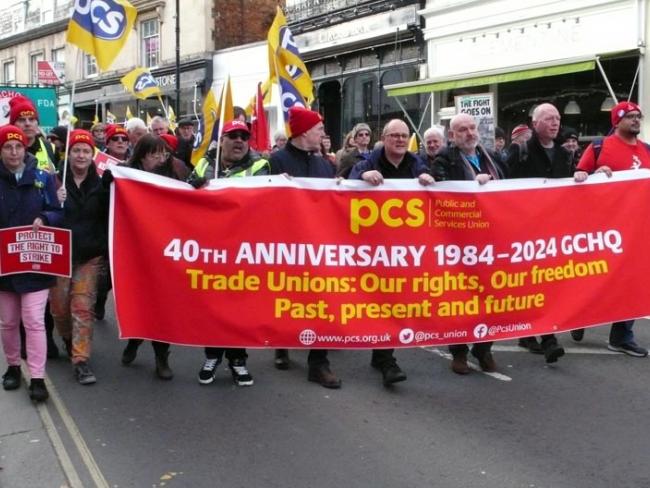
Cheltenham, 2024: still there, 40 years on. Photo Workers.
Forty years ago workers at a government intelligence centre stood out against a ban on union membership…
The TUC march in January against the latest trade union laws came 40 years after the Thatcher government banned workers at the GCHQ intelligence centre in Cheltenham from being members of an independent trade union.
The ban lasted 13 years, despite widespread opposition, many demonstrations, court cases and a tireless campaign by sacked workers and their unions. But it was less a story of a few heroic martyrs, and more about workers seeing the threat if government could dictate which organisations they belonged to – and having the courage to do something about it.
Shock
The ban came as a complete shock to union members at GCHQ, to other civil servants and to union members across Britain. The reaction was immediate: workers saw it as a step towards limiting the ability of workers more widely to organise and fight for their conditions.
It put an unlikely and unassuming group of people into the front line of the conflict between workers and the Thatcher government.
The pretext for the ban was that being a member of an independent union created a “conflict of loyalties” for those working at the intelligence base – whose existence and role was only publicly admitted the previous year.
Union members at GCHQ were angry about that accusation. They were adamant that their actions had never compromised national security. A former minister later admitted that was indeed the truth.
The US security agency was behind the ban – then as now, its work is closely integrated with GCHQ. But there’s little doubt the Thatcher government was in favour, possibly of a wider ban across other civil service areas too.
‘Union members at GCHQ were angry. They were adamant that their actions had never compromised national security…’
The origin of the ban was the 1981 civil service pay dispute. Civil service unions had reached a dead end with government’s refusal to negotiate a reasonable pay deal. They called a one-day strike, followed by other action including selective strikes – not at GCHQ, but in key areas like tax collection. The government was able to ride that out, in part due to cash from areas like the Post Office – which, ironically, was later privatised.
Although the unions did not win their claims, they ended with greatly strengthened organisation and experience. In many areas, civil servants were deciding for themselves how their organisations would be run during the dispute. The government, for example. relied on a few senior managers to sort and deliver mail that no one else would touch, and tried to intimidate union officials with legal action.
Refused
Many of those threatened at GCHQ with giving up their union membership or being sacked reluctantly accepted what had happened. But 130 out of 7,000 refused to sign away their trade union rights and stood out against the ban. Few, if any, people saw the creation of the in-house GCHQ Staff Federation as any substitute for an independent union.
A group, GCHQ Trade Unions, quickly organised itself to fight the ban in a high-profile way. Its campaign began with well supported rallies and marches, and speaking at union gatherings across the country.
The ban was held to be in contravention of International Labour Organization conventions. GCHQ workers were denied any access to employment tribunals. Their unions took court action to have the ban overturned, at first succeeding, but eventually losing in November 1984 on unspecified grounds of “national security”.
GCHQ Trade Unions then knew it was in for a long fight, with its own commitment and the support of their fellow workers being the way forward. The last 14 workers holding out and still working at GCHQ were dismissed between November 1988 and March 1989.
None of those sacked were found to have breached national security in any way. Indeed, the only wrongdoing in that period was the persistent victimisation of the 14 by GCHQ management.
Eleven of them had taken part in a two-day pay strike in June 1987. Three had voted against and did not take part as that could have compromised national security, a position accepted by the whole group.
Dignified
The nature of the campaign changed once no members of GCHQ trade unions were working there. But they were not finished. Always dignified and committed, they took whatever opportunity they found to build support for lifting of the ban and their eventual return.
It may seem odd that a small group of workers who remained committed to the British government and its security alliance with the USA could present such a threat. It was their own commitment to what they believed right and their independence that was the threat – not any supposed “national security”.
Three of the workers returned to GCHQ (the others had retired or decided to stay with new careers), and a lifting of the ban was met in the same straightforward and determined way the campaign was waged: they marched back on their own terms. Full pension rights were restored and those sacked were compensated.
But there was a catch. Delicate negotiations had paved the way to the staff federation members joining an independent union. A “collective agreement” managing any security risks was much on the lines the TUC had proposed in 1984. As one of the 14 said, accepting but not endorsing the agreement, it did nothing more to assure national security than did the pre-1984 position of trust that GCHQ workers enjoyed and lived up to.
